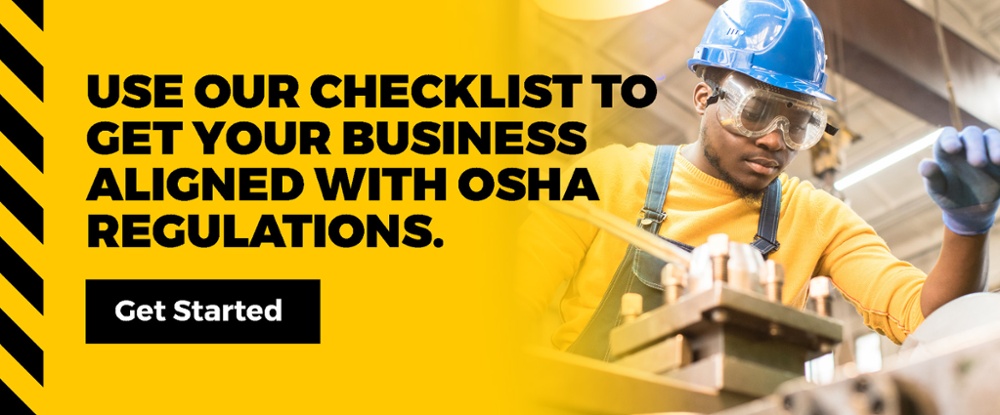Safety programs are essential components of business management, and assuming common sense will prevail is a dangerous and expensive way to learn otherwise.
While you may have policies in place, rapidly changing OSHA regulations can make it difficult to remain compliant. There is often a gap between the policy, training and on-site enforcement. Knowing the top 10 OSHA violations can help you identify key safety concerns and remediate them instead of incurring OSHA violations and fines.
OSHA Violations
OSHA regulations are designed to protect workers from harm. OSHA, the federal agency responsible for workplace safety, enforces compliance with citations and fines for violations. Depending on the severity, fines can be incredibly steep.
It is a misconception that OSHA only matters if an incident occurs. At best, you will face production delays and the costs of complying. More serious violations can result in fines of tens of thousands of dollars, not including the time lost for investigations, work stoppages and reputational damage. It is always less expensive to proactively design safety compliance.
Top 10 OSHA Violations
Understanding the most common OSHA violations can help inform your safety compliance strategies and policies. Ongoing safety vigilance can position you as an industry leader, and a track record of safe work practices can make you an attractive, low-risk partner on the worksite.
It's critical to understand the steps to take after an accident so that you're prepared. With far too many injuries continuing to occur, OSHA provides their most cited violations so that you can prevent accidents before they happen.
1. Fall Protection
Employers must provide fall protection systems to their employees at no cost. Protection includes guardrails, safety nets and personal fall arrest systems. It also includes a duty for the employer to ensure surfaces have the structural integrity to support employees.
Fall protection must be provided for any employee working 6 feet or more above a lower level, where they are working over dangerous equipment or where there is a danger of falling through holes. Employees must also be protected from objects that may fall through any such holes.
The inherent danger from falls is clear with OSHA regulation 1926.501 having over 20 subsections prescribing the employer’s duty to have fall protection under a variety of scenarios.
2. Hazard Communication
Hazard communication requires employers to communicate the risks of the chemicals employees work with. There must be written communication, including signage, labeling and Safety Data Sheets for every chemical in the workplace. Personal Protective Equipment must be provided and worn as indicated for each chemical.
3. Respiratory Protection
Employers must have a respiratory protection program. Any employee using a respirator must be medically evaluated and have their respirator fit tested at regular intervals, and the equipment must have regular cleaning and repair. Employees must show they understand why the respirator is required, how it should fit, how to use it and what to do if it fails.
4. Scaffolding
Scaffolding must be designed by a qualified person and constructed according to the design provided. Employers must ensure there are proper footings, access points and provide adequate fall protection, including protection from falling objects and electrical hazards.
5. Ladders
Ladders must be secure and in good working order. Depending on the type and height of the ladder, it must support several times the intended load. With over 20 subsections, ladders continue to be a serious concern, and employers must ensure employees are properly trained.
6. Control of Hazardous Energy
Also called lockout/tagout, employers must provide written procedures and training on the correct sequence to isolate equipment prior to service to prevent the release of energy during maintenance or repair.
7. Powered Industrial Trucks
Covering powered forklifts and motorized hand trucks, employers have a duty to ensure the operator of each truck is properly trained in its operation, including written records of their ongoing evaluations and recertifications. There are specific requirements for training, what defines competency, vehicle inspection and removal from service.
8. Fall Protection -- Training Requirements
Falling under its own standard (1926.503), employers must keep written records of all training for any employee who could be exposed to a falling hazard. The person conducting the training must be qualified, and employees must undergo periodic evaluation to ensure they have adequate understanding of the requirements.
9. Eye and Face Protection
Employees must receive training on the hazards requiring eye and face protection, including flying particles, gases, vapors, acids, molten metal or radiation. Employers must ensure they provide the appropriate protection for employees and the employee understands how to use it.
10. Machinery and Machine Guarding
Proper machine guarding protects machine operators from severe injuries from blades, chips, sparks, nip points and rotating parts. Employees must be trained on the safe operation of machinery, including inspection and leaving fixed guards in place.
Related Content: How OSHA Regulations Can Protect Contractors from Work-Related Injuries
Final Thoughts
While these are the most common OSHA violations, the regulations change often, and the nuances of compliance can be complicated, even when you know what to look for. Safety audits, corrective action plans and a top-down safety culture can help protect your employees and your company. Whether you are beginning a safety program or need help with an overhaul, contacting a safety consultant can speed


















